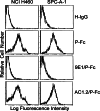Chemically modified heparin inhibits the in vitro adhesion of nonsmall cell lung cancer cells to P-selectin
- PMID: 16331491
- PMCID: PMC12161057
- DOI: 10.1007/s00432-005-0061-9
Chemically modified heparin inhibits the in vitro adhesion of nonsmall cell lung cancer cells to P-selectin
Abstract
Purpose: Several independent studies have indicated that tumor metastasis can be inhibited by chemically modified heparin with low anticoagulant activity in the different tumor models. The mechanism of inhibition by the heparin derivatives in part accounts for the interference of tumor cell-platelet interaction mediated by P-selectin.
Methods: In the present study, we demonstrated that both heparin and chemically modified heparins inhibited the adhesion of nonsmall cell lung cancer (NSCLC) cells to P-selectin under static or flow conditions in vitro.
Results: Flow cytometric analysis with the heparan sulfate-specific monoclonal antibody revealed that both NSCLC cells express heparan sulfate-like proteoglycans. Furthermore, heparinase treatment impaired P-selectin binding, indicating that heparan sulfate-like proteoglycans on the tumor cell surface are implicated in the adhesion of NSCLC cells to P-selectin.
Conclusions: These findings suggest that some chemically modified heparins with low anticoagulant activity may deserve further testing in the experimental NSCLC treatment protocols.
Figures





Similar articles
-
Chemically modified heparin inhibits in vitro L-selectin-mediated human ovarian carcinoma cell adhesion.Int J Gynecol Cancer. 2009 May;19(4):540-6. doi: 10.1111/IGC.0b013e3181a44bc8. Int J Gynecol Cancer. 2009. PMID: 19509548
-
Modified heparin inhibits P-selectin-mediated cell adhesion of human colon carcinoma cells to immobilized platelets under dynamic flow conditions.J Biol Chem. 2004 Jul 9;279(28):29202-10. doi: 10.1074/jbc.M312951200. Epub 2004 May 7. J Biol Chem. 2004. PMID: 15133030
-
Platelets promote the adhesion of human hepatoma cells with a highly metastatic potential to extracellular matrix protein: involvement of platelet P-selectin and GP IIb-IIIa.J Cancer Res Clin Oncol. 2002 May;128(5):283-7. doi: 10.1007/s00432-002-0325-6. Epub 2002 Mar 7. J Cancer Res Clin Oncol. 2002. PMID: 12029445 Free PMC article.
-
The complex effects of heparins on cancer progression and metastasis in experimental studies.Pharmacol Rev. 2001 Mar;53(1):93-105. Pharmacol Rev. 2001. PMID: 11171940
-
A rapid and systematic review of the clinical effectiveness and cost-effectiveness of paclitaxel, docetaxel, gemcitabine and vinorelbine in non-small-cell lung cancer.Health Technol Assess. 2001;5(32):1-195. doi: 10.3310/hta5320. Health Technol Assess. 2001. PMID: 12065068
Cited by
-
Acetylation may strengthen the antitumor activity of low molecular heparin.Transl Cancer Res. 2021 Jan;10(1):461-468. doi: 10.21037/tcr-20-2195. Transl Cancer Res. 2021. PMID: 35116275 Free PMC article.
-
Anticancer Effect of Heparin-Taurocholate Conjugate on Orthotopically Induced Exocrine and Endocrine Pancreatic Cancer.Cancers (Basel). 2021 Nov 18;13(22):5775. doi: 10.3390/cancers13225775. Cancers (Basel). 2021. PMID: 34830928 Free PMC article.
-
Chemically modified heparins inhibit fibrinogen-bridged indirect adhesion between tumor cells and platelets.Oncol Lett. 2012 Feb;3(2):497-502. doi: 10.3892/ol.2011.510. Epub 2011 Dec 2. Oncol Lett. 2012. PMID: 22740939 Free PMC article.
-
Platelets and fibrinogen facilitate each other in protecting tumor cells from natural killer cytotoxicity.Cancer Sci. 2009 May;100(5):859-65. doi: 10.1111/j.1349-7006.2009.01115.x. Epub 2009 Mar 11. Cancer Sci. 2009. PMID: 19302289 Free PMC article.
-
C-type lectins facilitate tumor metastasis.Oncol Lett. 2017 Jan;13(1):13-21. doi: 10.3892/ol.2016.5431. Epub 2016 Nov 24. Oncol Lett. 2017. PMID: 28123516 Free PMC article.
References
-
- Burdick MM, McCaffery JM, Kim YS, Bochner BS, Konstantopoulos K (2003) Colon carcinoma cell glycolipids, integrins, and other glycoproteins mediate adhesion to HUVECs under flow. Cell Physiol 284:C977–987 - PubMed
Publication types
MeSH terms
Substances
LinkOut - more resources
Full Text Sources
Other Literature Sources
Medical

